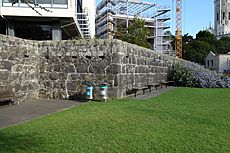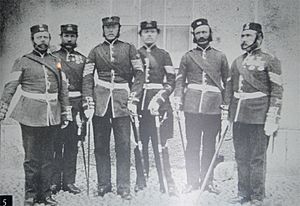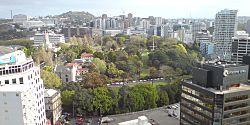Albert Barracks facts for kids
Quick facts for kids Albert Barracks |
|
|---|---|

Albert Barracks wall remnant in 2016
|
|
| General information | |
| Address |
|
| Coordinates | 36°51′4.21″S 174°46′11.24″E / 36.8511694°S 174.7697889°E |
| Completed | 1850 |
| Designated: | 23 June 1983 |
| Reference #: | 12 |
The Albert Barracks was a large military base for the British army. It was located in Auckland, New Zealand, from the mid-1840s to 1870. This was during the early years when Auckland was a British colony.
The barracks overlooked the city. Its strong outer wall was built between 1846 and the early 1850s. Today, much of the area is covered by Albert Park and the University of Auckland. Princes Street now runs right through the middle of where the barracks once stood. Only a small part of the original wall remains on the university campus.
Contents
Building the Barracks
The barracks were built to make the people of Auckland feel safe. This was after a conflict called the Flagstaff War in 1845–1846. At that time, Auckland was the capital city of New Zealand.
Work on the outer wall began in December 1846. George Graham oversaw the building of this wall. It enclosed an area of about 22 acres (9 hectares).
The wall was made from a type of volcanic rock called scoria. This stone came from a quarry in Mount Eden. Both European and local Māori workers helped build it. Māori workers were new to this type of building. They received training, and their work was just as good as the Europeans'.
The good quality and speed of their work impressed everyone. This led to a night school being set up for Māori workers. They could get more training there. Also, a special pay system was created. It had three levels, so skilled Māori workers earned more.
Many buildings were also built inside the wall. These included places for storing military supplies, a hospital, and a theatre. There was also a large area for soldiers to practice drills. The first hospital was a stone building. It could hold about 50 patients. Later, during the Invasion of the Waikato in 1863, more temporary hospitals were needed.
In 1866, the place where gunpowder was stored moved. It went to the Mount Eden stockade, near Mount Eden Prison.
Soldiers at the Barracks
The first soldiers at Albert Barracks were from the 65th Regiment. In 1849, the 58th Regiment took their place.
In 1855, some soldiers from the 58th Regiment went to Taranaki. There were worries about land sales and possible attacks by local Māori.
The Auckland Volunteer Rifles group formed in 1858. They used Albert Barracks for their training. The 65th Regiment returned to Auckland in October 1858. The 58th Regiment then left for England.
In March 1860, 200 men from the 65th Regiment went to Taranaki. They were sent to help the soldiers already there. Their arrival started the First Taranaki War. The local Auckland Militia was called to gather at Albert Barracks in May 1860. This group had four parts, with one based at Albert Barracks.
More soldiers from the 65th Regiment and Royal Engineers arrived in June 1860. In November 1860, the 65th Regiment left. They were replaced by soldiers from the 14th Regiment and later the 57th Regiment.
By May 1861, there were about 800 men from the 65th Regiment. There were also about 200 men from the Royal Artillery and 50 from the Royal Engineers. These groups stayed until February 1862. After that, the local militia guarded the barracks.
In 1863, soldiers from the 40th Regiment were at the barracks. They were later replaced by the 65th Regiment. Then the 50th Regiment arrived. Most of these soldiers were sent to fight in different conflicts. These included the Waikato invasion and the Second Taranaki War.
From 1865, the British army started to leave New Zealand. By 1867, the local militias were in charge of defense. The last British soldiers left in February 1870. The barracks land and buildings were then given to the New Zealand Government.
Life and Events at the Barracks
In 1849, the crew of a French ship that had crashed were housed at the barracks. They stayed for seven weeks while waiting to go home.
The barracks grounds were also used for cricket games in 1850. The buildings hosted dances and plays from 1849 onwards.
Auckland had problems with sewage disposal up to 1857. The barracks, with its 1,000 residents, made the problem worse. Heavy rain caused sewage to overflow and run into the city. The city council asked the military for help. Colonel Thomas Mould of the Royal Engineers said they would fix it if the city installed proper sewer pipes. A sewer system was finally built in 1863. This was after several outbreaks of typhoid fever in the city.
In 1863, a large fire happened near the barracks. People worried that if the wind changed, the fire could reach the gunpowder storage. There were about 100 tons of gunpowder there. After this, a series of fires broke out at the barracks in March 1863. People thought an arsonist was responsible. The fires stopped after the military set a curfew at the barracks.
Changing the Barracks Site
When the last soldiers left in 1870, some buildings were sold and removed. The site was still used for cricket and military parades. In 1871, Auckland Grammar School started using a building there.
The land was officially given to the Auckland Province. A group called the Auckland Improvement Commissioners was set up. They were in charge of managing the land. They were allowed to remove the wall and buildings, except for one military store. In 1873, this store was moved to the old hospital building.
Albert Barracks Today
The area where Albert Barracks once stood is now busy. It is bordered by Kitchener Street, Waterloo Quadrant, Symonds Street, and Wellesley Street East. Princes Street runs through the middle.
Today, Albert Park covers the western part of the site. The University of Auckland's city campus is on the eastern side. A building called University House (which used to be a synagogue) is also on the site.
The only part of the barracks that remains is about 85 meters (279 feet) of the outer wall. This wall is the oldest surviving piece of British military building in New Zealand. In 1983, the Albert Barracks Wall was recognized as a very important historical structure.
Images for kids






